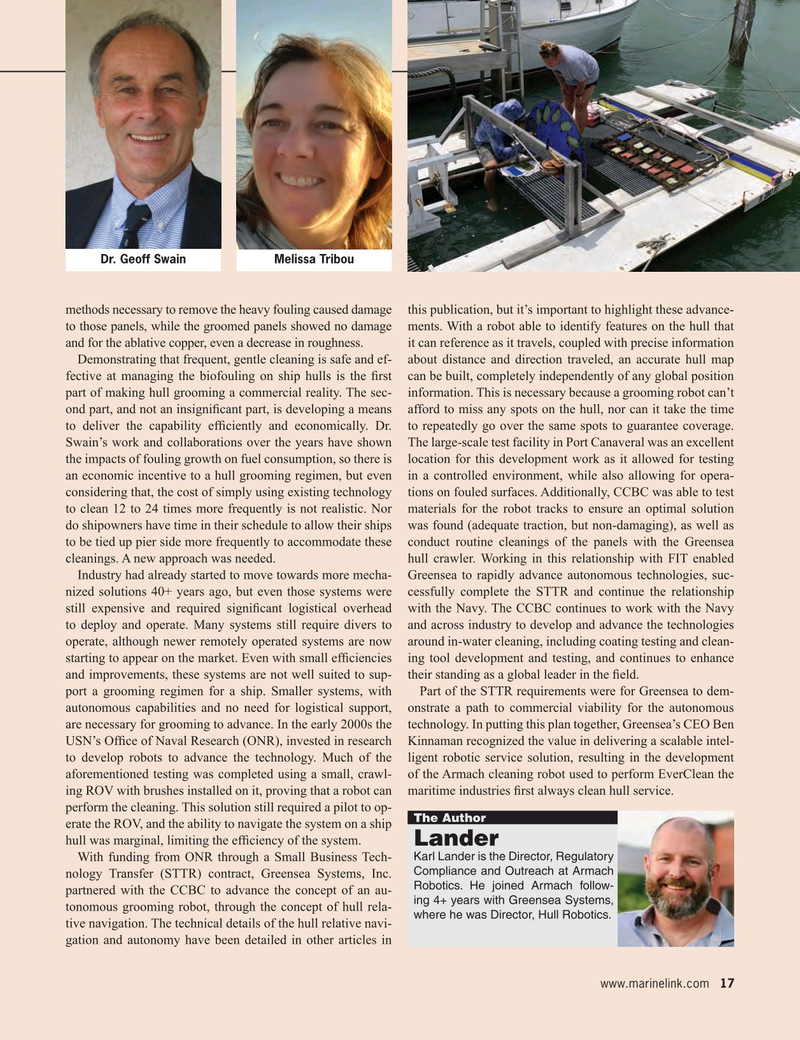
Page 17: of Maritime Reporter Magazine (May 2023)
Green Ship Technologies
Read this page in Pdf, Flash or Html5 edition of May 2023 Maritime Reporter Magazine
Dr. Geoff Swain Melissa Tribou methods necessary to remove the heavy fouling caused damage this publication, but it’s important to highlight these advance- to those panels, while the groomed panels showed no damage ments. With a robot able to identify features on the hull that and for the ablative copper, even a decrease in roughness. it can reference as it travels, coupled with precise information
Demonstrating that frequent, gentle cleaning is safe and ef- about distance and direction traveled, an accurate hull map fective at managing the biofouling on ship hulls is the ? rst can be built, completely independently of any global position part of making hull grooming a commercial reality. The sec- information. This is necessary because a grooming robot can’t ond part, and not an insigni? cant part, is developing a means afford to miss any spots on the hull, nor can it take the time to deliver the capability ef? ciently and economically. Dr. to repeatedly go over the same spots to guarantee coverage.
Swain’s work and collaborations over the years have shown The large-scale test facility in Port Canaveral was an excellent the impacts of fouling growth on fuel consumption, so there is location for this development work as it allowed for testing an economic incentive to a hull grooming regimen, but even in a controlled environment, while also allowing for opera- considering that, the cost of simply using existing technology tions on fouled surfaces. Additionally, CCBC was able to test to clean 12 to 24 times more frequently is not realistic. Nor materials for the robot tracks to ensure an optimal solution do shipowners have time in their schedule to allow their ships was found (adequate traction, but non-damaging), as well as to be tied up pier side more frequently to accommodate these conduct routine cleanings of the panels with the Greensea cleanings. A new approach was needed. hull crawler. Working in this relationship with FIT enabled
Industry had already started to move towards more mecha- Greensea to rapidly advance autonomous technologies, suc- nized solutions 40+ years ago, but even those systems were cessfully complete the STTR and continue the relationship still expensive and required signi? cant logistical overhead with the Navy. The CCBC continues to work with the Navy to deploy and operate. Many systems still require divers to and across industry to develop and advance the technologies operate, although newer remotely operated systems are now around in-water cleaning, including coating testing and clean- starting to appear on the market. Even with small ef? ciencies ing tool development and testing, and continues to enhance and improvements, these systems are not well suited to sup- their standing as a global leader in the ? eld. port a grooming regimen for a ship. Smaller systems, with Part of the STTR requirements were for Greensea to dem- autonomous capabilities and no need for logistical support, onstrate a path to commercial viability for the autonomous are necessary for grooming to advance. In the early 2000s the technology. In putting this plan together, Greensea’s CEO Ben
USN’s Of? ce of Naval Research (ONR), invested in research Kinnaman recognized the value in delivering a scalable intel- to develop robots to advance the technology. Much of the ligent robotic service solution, resulting in the development aforementioned testing was completed using a small, crawl- of the Armach cleaning robot used to perform EverClean the ing ROV with brushes installed on it, proving that a robot can maritime industries ? rst always clean hull service. perform the cleaning. This solution still required a pilot to op-
The Author erate the ROV, and the ability to navigate the system on a ship hull was marginal, limiting the ef? ciency of the system.
Lander
Karl Lander is the Director, Regulatory
With funding from ONR through a Small Business Tech-
Compliance and Outreach at Armach nology Transfer (STTR) contract, Greensea Systems, Inc.
Robotics. He joined Armach follow- partnered with the CCBC to advance the concept of an au- ing 4+ years with Greensea Systems, tonomous grooming robot, through the concept of hull rela- where he was Director, Hull Robotics. tive navigation. The technical details of the hull relative navi- gation and autonomy have been detailed in other articles in www.marinelink.com 17
MR #5 (1-17).indd 17 5/5/2023 3:16:33 PM

 16
16

 18
18
